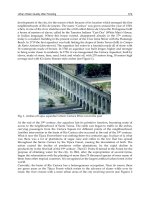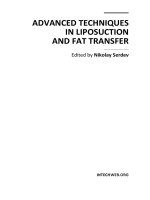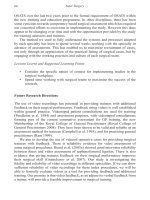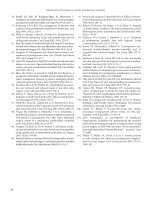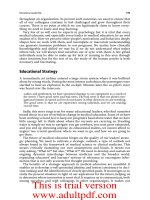Advanced Techniques in Dermatologic Surgery - part 10 ppt
Bạn đang xem bản rút gọn của tài liệu. Xem và tải ngay bản đầy đủ của tài liệu tại đây (1.58 MB, 41 trang )
and amount of tumescent anesthesia placed around the vein. A uniform
layer of blood circumferentially around the fiber will yield the best results
with the hemoglobin targeting wavelengths.
One in vitro study model has predicted that therm al gas production
by laser heating of blood in a 6 mm tube results in 6 mm of thermal
damage (23,24). These authors used a 940 nm diode laser with multiple
15-J, 1 sec pulses to treat the GSV. An median of 80 pulses (range, 22–
116) were applied along the treated vein every 5–7 mm. Histologic exam-
ination of one excised vein demonstrated thermal damage along the
entire treated vein with evidence of perforations at the point of laser
application described as ‘‘explosive-like’’ photo-disruption of the vein
wall. This produced the homogeneous thrombotic occlusion of the vessel.
Since optical properties of a 940 nm laser beam within circulating blood is
that it can only penetrate 0.3 mm, the formation of steam bubbles is the
mechanism of action of heating surrounding tissue (24).
Initial reports have shown this technique with an 810 nm diode laser
to have good short-term efficacy in the treatment of the incompetent
GSV, with 96% or higher occlusion at 9 months with a less than 1% inci-
dence of transient paresthsia (25,26). Most patients, however, experience
major degrees of post-operative ecchymosis and discomfort. Skin burns
have observed by one of the authors (RAW). Deep venous thrombosis
extending into the femoral vein have also been recently reported with
endovenous laser treatment (27).
Our patients treated with an 810 nm diode laser have shown an
increase in post-treatment purpura and tenderness. Most of our patients
do not return to complete functional normality for 2–7 days as opposed
to the 1 day ‘‘downtime’’ with RF Closure
TM
of the GSV. There is even
less downtime with CTEV
TM
, discussed in the next section. Recent studies
suggest that pulsed 810 nm diode laser treatment with its increased risk for
perforation of the vein (as opposed to continuous treatment which does
not have intermittent vein perfor ations but may have irregular areas of
perforation) may be responsible for the increase symptoms with 810 nm
laser vs. RF treatment (28). Our experience wi th trying to vary the fluence
and treating with a continuous laser pull back vs. pulsed pull back has not
resulted in an elimination of vein perforation using an 810 nm diode laser.
A longer wavelength such as 940 nm has been hypothesized to pene-
trate deeper into the vein wall with resulting increased efficacy. A report of
280 patients with 350 treated limbs with 18 month follow-up demon-
strated complet e closure in 96% (29). Twenty vein segments were exam-
ined histologically. Veins were treated with 1 sec duration pulses at 12 J.
Perforations were not present. When the fluence was increased to 15 J with
1.2- and 1.3-sec pulses, microperforations did occur and were said to be
self-sealing. The author suggests that his use of tumescent anesthesia as
well as the above mentioned laser parameters are responsible for the lack
of significant perforations and enhanced efficacy.
A clinical study using an endoluminal 1064 nm Nd:YAG laser in the
treatment of incompetent GSV in 151 men and women with 252 treated
limbs was reported (30). Unfortunately, the surgeons also ligated the SFJ,
358 Weiss and Goldman
which did not allow for a determination of the efficacy of SFJ ablation.
Spinal anesthesia was used and the laser was used at 10–15 W of energy with
10 sec pulses with manual retraction of the laser fiber at a rate of 10 sec/cm.
Skin overlying the treated vein was cooled with cold water. Unfortunately,
this resulted in superficial burns in 4.8% of patients, paresthesia in 36.5%,
superficial phlebitis in 1.6%, and localized hematomas in 0.8%.
COOLTOUCH CTEV
TM
ENDOVENOUS TREATMENT
In an attempt to bypass the problems associated with laser wavelength
absorption of hemoglobin, we have developed a 1320 nm endolumenal laser.
At this wavelength, tissue water is the target and the presence or absence of
red blood cells within the vessels is unimportant. The CoolTouch CTEV
TM
treatment is an endovenous ablation method using a special laser fiber
coupled to the intraluminal use of an infrared 1320nm wavelength with
an automatic pullback device pre-set to pullback at 1 mm/sec (Fig. 5). This
1.32 micron wavelength is unique among endovenous ablation lasers in that
this wavelength is absorbed only by water and not by hemoglobin. This
makes it significantly different from the other (hemoglobin targeting) wave-
lengths u sed for en dovenous laser treatments. In our opinion and ex peri-
ence, the CoolTouch CTEV
TM
at 1320 nm is significantly superior to the
other endovenous laser methods both by v i rtue of the water absorption
and the automatic pullback device (31).
When using a wavelength strongly absorbed by hemoglobin, such as
810 nm, there i s a lot of intraluminal b lood hea ting w ith t ransmission of heat
to the surrounding tissue through long heating times. Temperatures in animal
models have been reported as high as 1200
C (28). When we have tried ex
vivo vein treatment w ithout blood w ith the fiber in contac t with the vein wall,
the 810 nm wavelength simply chars the inside of the vein. When blood is
added to exvivo veins and is then treated with 810 nm, numerous vein explo-
sions ar e observed (personal communication, Dr. M. Hirokawa, T ok yo,
Japan, 200 5).
Minimizing direct contact with the vein wall for hemoglobin-depen-
dent methods minimizes the charring of the vein wall and probably lowers
the post-operative pain levels. Ideally for a hemoglobin absorbed wave-
length to work, it would be best to have a well-defined layer of hemoglobin
between the fiber and the vein wall. In the real world, however, varicose
veins are saccular and irregular pockets of hemoglobin are frequently
encountered leading to sharp rises in temperature and vein perforations
when using hemoglobin absorbing wavelengths such as 810 nm.
Using tumescent anesthesia with a hemoglobin targeting wavelength,
it can be very difficult to gauge the correct amount to compress the vein since
some hemoglobin is necessary for the mechanism of action. If too much
tumescence is used, there can be charring of the inner wall of the vein with-
out heating of the vein wall, with resulting pain and failure to close the v ein.
For all these potential obstacles to ideal treatment conditions for 810 nm,
940 nm, or 980 nm, it makes far more sense to use a water absorbing
Endovenous Elimination with Radiofrequency or Laser 359
wavelength once cannulated within the vein. Therefore, the 1320 nm wave-
length for use in endovenous ablation was explored and clinical trials per-
formed resulting in FDA clearance in September 2004 for treatment of the
greater saphenous vein. By August 2005, sufficient data for approval for
obliteration of reflux in the lesser saphenous vein were cleared by the FDA.
Percutaneous approaches to smaller leg telangiectasias indicate
that deeply penetrating laser wavelengths with significant deoxyhemo-
globin absorption, such as 1064 nm Nd:YAG, have the most utility.
When veins are targeted through the skin, one exploits the concept of
selective photothermolysis. By targeting deoxyhemoglobin, cutaneous
Figure 5
CoolTouch CTEV
TM
1320 nm laser and automatic pullback device.
360 Weiss and Goldman
leg vessels absorb preferentially to surrounding water, collagen, and
other structures. This allows selective destruction of tiny blood vessels
without heating surrounding structures. The mechanism of this destruc-
tion by 1064 nm laser must be clearly understood by the user. The clinical
observation is immediate photodarkening and coagulation. Histologi-
cally this is represented by perivascular hemorrhage and thrombi with
vessels fragmentation (32). This ultimately leads to vessel clearance in
about 75% of targeted areas over a 3-month time frame (33). For the
cutaneous approach, this is clearly state-of-the-art but this is not the best
approach for endov enous laser ablation in which selective photother mo-
lysis is not a factor.
Endovenous ablation requires maximizing vein shrinkage and
closure with the least amount of blood coagulation and the maximum
amount of vein wall contraction. We know from earlier methods invol-
ving electrosurgical blood coagu lation that the long-term success rates
based on coagulation of blood are very low (34,35). On the contrary,
success rates for radiofrequency vein shrinkage specifically avoiding
coagulation of blood are very high (5,13,36). Recently, Proebstle and col-
leagues designed a study that answers the question of whether endove-
nous ablation is best accomplished by hemoglobin heating or the
approach of using water around the collagen in the vein wall as a target
(37). He has had extensive experience with the 940 nm wavelength for
endovenous ablation (38). As shown by Proebstle et al., there is a clear
advantage of targeting water over hemoglobin when performing endove-
nous laser. There is a statistically reduced rate of pain post-operatively
with a higher rate of success while at the same time applying lower
energy. This results in greater safety and efficacy for the patient, our
own experience reflects this, with a reduction in pain and bruising of
80% when switching from 810 nm endovenous to 1320 nm endovenous.
Having treated over 200 greater saphenous veins with 1320 nm, our
incidence of mild pain is 5%. No significant pain interfering with walking
has been observed. A typical clinical result is shown in (Fig. 6).
Based on our experience we believe that there is reduced pain
reported with 1320 nm vs 940 nm probably due to less vein perforations
and more uniform heating by 1320 nm targeting water in the vein wall.
Rarely, patients experience mild pain after 1320 nm, but this is probably
related to heat dissipated into surrounding tissue, not vein perforations.
This might be minimized by using the minimal effective energy to shrink
the vein. In our own unpublished studies we have found that emitting 5W
of 1320 nm through a 600-m fiber moving at 1 mm/sec in a 2-mm thick
vein wall, the highest temperature recorded on the exterior of the vein
wall was 48
C. Unfortunately in a saphenous vein, for effective sealing
and shrinkage, higher energies must sometimes be utilized. In the
Proebste et al. (37) study, 8 W of 1320 nm were employed to have the
highest intraluminal occlusion and shrinkage but probably accounted
for the post-operative pain incidence. We believe that effective energy
for vein sealing in our practice is mostly between 5 and 6, thus minimi-
zing post-operative pain to less than 5%. In summary, our experience
Endovenous Elimination with Radiofrequency or Laser 361
and those of others indicate that 1320 nm water targeting vs. 810 nm,
940 nm, or 980 nm hemoglobin targeting endovenous occlusion is gentler,
leading to far less bruising and post-operative pain.
TECHNIQUE OF COOLTOUCH CTEV
TM
ENDOVENOUS
TREATMENT
The patient is evaluated and marked in an identical manner as with RF
Closure
TM
of the GSV. An appropriate entry point is selected similar to
RF. This is usually just below where reflux is no longer seen in the greater
saphenous vein. For the majority of patients in our series this is at a point
just above or below the knee along the course of the GSV. A sheath is
placed in the entire length of the vein to be treated up to the sapheno-
femoral junction. Tumescent anesthesia is then injected along the vein
and injected subfacially to separate and dissect the targeted vein, and
to provide a layer of thermal protection around the vein. Some blood
is always in the vein and that gets gently heated from its water content.
Direct fiber contact with the vein wall is not important as the energy
for heating water is propelled in an arcing field from the distal end of
Figure 6
Clinical result seen with CoolTouch CTEV
TM
1320 nm laser. (A) Before treat-
ment. (B) After 6 weeks. There is marked improvement of a varicosity asso-
ciated with reflux of the greater saphenous vein.
362 Weiss and Goldman
the fiber facing into the lumen proximally. Once tumescent anesthesia is
achieved and totally surrounds the targeted vein, a 600 um laser fiber is
inserted with CTEV
TM
. A helium neon aiming beam that is continuously
illuminated when the laser is on ensures that the laser fiber is in the super-
ficial venous syst em and can be used to monitor automatic pullback
visually. The sheath acts to protect the vein during the insertion of the
optical fiber. However, the sheath must be completely removed from
the vein prior to application of laser energy. This is performed so that
the automatic pullback device may pullback the fiber unimpeded. If the
laser fiber retracts within the sheath thermal destruction of the sheath
occurs with no energy transmission to the vein wall.
Correct placement of the laser fibe r tip 2 cm distal to the SFJ is con-
firmed through Duplex visualization of the fiberoptic in the tumescent
anesthesia compressed saphenous vein combined with viewing the aiming
beam through the skin. Pullback is set for 1 mm/sec and the laser is set
for 5–6 W at 50 Hz. The laser is fired for 2–3 sec to visualize sealing of the
targeted vein on Duplex. The laser is then stopped for a moment while
the pullback device is turned on. Once the laser fiber is seen to be getting
pulled back on Duplex, the laser is immediately switched on. Vein shrink-
age can be monitored visually by Duplex ultrasound as the water is
heated circumferentially. Having the fiber pointed directly at a vein wall
should be avoided. The progress can be monitored by Duplex or visually
by the aiming beam reaching the skin surface from within the vein. As the
fiber approaches the entry site, the laser is stopped.
SUMMARY
The latest techniques for endovenous occlusion using radiofrequency
ablation catheters or endoluminal laser targeting water are our preferred
methods to treat saphenous related varicose veins. These methods are
well proven to offer a less invasive alternative to ligation and stripping
and can be supplemented by sclerotherapy, particularly foamed sclero-
sant scler otherapy. Clinical experience with endovenous techniques in
over 1000 patients shows a high degree of success with minimal side
effects, most of which can be prevented or minimized with use of tumes-
cent anesthesia. Tumescent anesthesia is critical to the safety of endove-
nous techniques. Within the next 5 years, these minimally invasive
endovenous ablative procedures involving saphenous trunks should have
virtually replaced open surgical strippings. Already over 100,000 patients
have been treated worldwide.
Endovenous Elimination with Radiofrequency or Laser 363
REFERENCES
1. Munn SR, Morton JB, MacBeth WAAG, McLeish AR. To strip or not to strip the long
saphenous vein? A varicose vein trial. Br J Surg 1981; 68:426–428.
2. McMullin GM, Coleridge Smith PD, Scurr JH. Objective assessment of high ligation
without stripping the long saphenous vein. Br J Surg 1991; 78:1139–1142.
3. Rutherford RB, Sawyer JD, Jones DN. The fate of residual saphenous vein after partial
removal or ligation. J Vasc Surg 1990; 12:422–428.
4. Sarin S, Scurr JH, Coleridge Smith PD. Assessment of stripping the long saphenous vein
in the treatment of primary varicose veins. Br J Surg 1992; 79:889–893.
5. Weiss RA, Weiss MA. Controlled radiofrequency endovenous occlusion using a unique
radiofrequency catheter under duplex guidance to eliminate saphenous varicose vein
reflux: a 2-year follow-up. Dermatol Surg 2002 Jan; 28(1):38–42.
6. Goldman MP, Amiry S. Closure of the greater saphenous vein with endoluminal radio-
frequency thermal heating of the vein wall in combination with ambulatory phlebectomy:
50 patients with more than 6-month follow-up. Dermatol Surg 2002 Jan; 28(1):29–31.
7. Olgin JE, Kalman JM, Chin M, Stillson C, Maguire M, Ursel P, et al. Electrophysiolo-
gical effects of long, linear atrial lesions placed under intracardiac ultrasound guidance.
Circulation 1997 Oct 21; 96(8):2715–2721.
8. Gradman WS. Venoscopic obliteration of variceal tributaries using monopolar electro-
cautery. J Dermatol Surg Onc 1994; 20(7):482–485.
9. Cragg AH, Galliani CA, Rysavy JA, Castaneda-Zuniga WR, Amplatz K. Endovascular
diathermic vessel occlusion. Radiology 1982 Jul; 144(2):303–308.
10. Haines DE. The biophysics of radiofrequency catheter ablation in the heart: the impor-
tance of temperature monitoring. Pacing Clin Electrophysiol 1993 Mar; 16(3 Pt 2):586–
591.
11. Haines DE, Verow AF. Observations on electrode-tissue interface temperature and effect
on electrical impedance during radiofrequency ablation of ventricular myocardium. Cir-
culation 1990 Sep; 82(3):1034–1038.
12. Lavergne T, Sebag C, Ollitrault J, Chouari S, Copie X, Le HJ, et al. [Radiofrequency
ablation: physical bases and principles]. Arch Mal Coeur Vaiss 1996 Feb; 89 Spec No
1:57–63:57–63.
13. Pichot O, Kabnick LS, Creton D, Merchant RF, Schuller-Petroviae S, Chandler JG.
Duplex ultrasound scan findings two years after great saphenous vein radiofrequency
endovenous obliteration. J Vasc Surg 2004 Jan; 39(1):189–195.
14. Lurie F, Creton D, Eklof B, Kabnick LS, Kistner RL, Pichot O, et al. Prospective ran-
domized study of endovenous radiofrequency obliteration (closure procedure) versus
ligation and stripping in a selected patient population (EVOLVeS Study). J Vasc Surg
2003 Aug; 38(2):207–214.
15. Merchant RF, Depalma RG, Kabnick LS. Endovascular obliteration of saphenous
reflux: a multicenter study. J Vasc Surg 2002 Jun; 35(6):1190–1196.
16. Weiss RA, Goldman MP. Transillumination mapping prior to ambulatory phlebectomy.
Dermatol Surg 1998; 24:447–450.
17. Smith SR, Goldman MP. Tumescent anesthesia in ambulatory phlebectomy. Dermatol
Surg 1998 Apr; 24(4):453–456.
18. Goldman MP. Closure of the greater saphenous vein with endoluminal radiofrequency
thermal heating of the vein wall in combination with ambulatory phlebectomy: prelimin-
ary 6-month follow-up. Dermatol Surg 2000 May; 26(5):452–456.
19. Chandler JG, Pichot O, Sessa C, Schuller-Petrovic S, Osse FJ, Bergan JJ. Defining the
role of extended saphenofemoral junction ligation: a prospective comparative study. J
Vasc Surg 2000 Nov; 32(5):941–953.
364 Weiss and Goldman
20. Manfrini S, Gasbarro V, Danielsson G, Norgren L, Chandler JG, Lennox AF, et al.
Endovenous management of saphenous vein reflux. Endovenous Reflux Management
Study Group. J Vasc Surg 2000 Aug; 32(2):330–342.
21. Sybrandy JE, Wittens CH. Initial experiences in endovenous treatment of saphenous vein
reflux. J Vasc Surg 2002 Dec; 36(6):1207–1212.
22. Komenaka IK, Nguyen ET. Is there an increased risk for DVT with the VNUS closure
procedure? J Vasc Surg 2002 Dec; 36(6):1311.
23. Proebstle TM, Sandhofer M, Kargl A, Gul D, Rother W, Knop J, et al. Thermal damage
of the inner vein wall during endovenous laser treatment: key role of energy absorption
by intravascular blood. Dermatol Surg 2002 Jul; 28(7):596–600.
24. Proebstle TM, Lehr HA, Kargl A, Espinola-Klein C, Rother W, Bethge S, et al. Endo-
venous treatment of the greater saphenous vein with a 940-nm diode laser: thrombotic
occlusion after endoluminal thermal damage by laser-generated steam bubbles. J Vasc
Surg 2002 Apr; 35(4):729–736.
25. Min RJ, Zimmet SE, Isaacs MN, Forrestal MD. Endovenous laser treatment of the
incompetent greater saphenous vein. J Vasc Interv Radiol 2001 Oct; 12(10):1167–1171.
26. Navarro L, Min RJ, Bone C. Endovenous laser: a new minimally invasive method of
treatment for varicose veins–preliminary observations using an 810 nm diode laser. Der-
matol Surg 2001 Feb; 27(2):117–122.
27. Mozes G, Kalra M, Carmo M, Swenson L, Gloviczki P. Extension of saphenous throm-
bus into the femoral vein: a potential complication of new endovenous ablation techni-
ques. J Vasc Surg 2005 Jan; 41(1):130–135.
28. Weiss RA. Comparison of endovenous radiofrequency versus 810 nm diode laser occlu-
sion of large veins in an animal model. Dermatol Surg 2002 Jan; 28(1):56–61.
29. Bush RG. Regarding ‘‘Endovenous treatment of the greater saphenous vein with a 940-
nm diode laser: thrombolytic occlusion after endoluminal thermal damage by laser-gen-
erated steam bubbles’’. J Vasc Surg 2003 Jan; 37(1):242.
30. Chang CJ, Chua JJ. Endovenous laser photocoagulation (EVLP) for varicose veins.
Lasers Surg Med 2002; 31(4):257–262.
31. Goldman MP, Mauricio M, Rao J. Intravascular 1320-nm Laser Closure of the Great
Saphenous Vein: A 6- to 12-Month Follow-up Study. Dermatol Surg 2004 Nov;
30(11):1380–1385.
32. Goldberg SN, Hahn PF, Tanabe KK, Mueller PR, Schima W, Athanasoulis CA, et al.
Percutaneous radiofrequency tissue ablation: does perfusion-mediated tissue cooling
limit coagulation necrosis? J Vasc Interv Radiol 1998 Jan; 9(1 Pt 1):101–111.
33. Weiss RA, Weiss MA. Early clinical results with a multiple synchronized pulse 1064 nm
laser for leg telangiectasias and reticular veins. Dermatol Surg. In press 1998.
34. Lewin JS, Connell CF, Duerk JL, Chung YC, Clampitt ME, Spisak J, et al. Interactive
MRI-guided radiofrequency interstitial thermal ablation of abdominal tumors: clinical
trial for evaluation of safety and feasibility. J Magn Reson Imaging 1998 Jan; 8(1):40–47.
35. Otsu A, Mori N. Therapy of varicose veins of the lower limbs by light coagulator.
Angiology 1971 Mar; 22(3):107–113.
36. Sofka CM. Duplex ultrasound scan findings two years after great saphenous vein radio-
frequency endovenous obliteration. Ultrasound Q 2004 Jun; 20(2):66.
37. Proebstle TM. Comparison of 940 nm and 1320 nm endovenous ablation. Dermatol
Surg. In press 2005.
38. Proebstle TM, Gul D, Kargl A, Knop J. Endovenous lasertreatment of the lesser saphenous
vein with a 940-nm diode laser: early results. Dermatol Surg 2003 Apr; 29(4):357–361.
Endovenous Elimination with Radiofrequency or Laser 365
19
Radiofrequency Tissue Tightening:
Thermage
Carolyn I. Jacob
Northwestern Medical School, Department of Dermatology, Chicago Cosmetic
Surgery and Dermatology, Chicago, Illinois, U.S.A.
Michael S. Kaminer
Department of Dermatology, Yale Medical School, Yale University, New Haven,
Connecticut, U.S.A.; Department of Medicine (Dermatology), Dartmouth
Medical School, Dartmouth College, Hanover, New Hampshire, U.S.A.; and
SkinCare Physicians of Chestnut Hill, Chestnut Hill, Massachusetts, U.S.A.
Video 22: Thermage
INTRODUCTION
Rapid advances in skin rejuvenation treatments have been seen in the
new millennium, with patient demand and improved technology driving
the development of treatments that require little or no recovery time. A
new nonlaser procedure for tightening the skin uses radiofrequency to
heat the dermis and potentially the subdermal tissues. The ThermaCool
TC
TM
by Thermage has been recently cleared by the FDA for the non-
invasive tightening of periorbital rhytides using this proven mechanism
of tissue tightening. In this chapter we will outline the new radio-
frequency technology and explore its place among the armamentarium
of facial rejuvenation. We will also briefly discuss early stage work that
uses this technology for acne treatment and body skin tightening.
To meet the demands of aging baby boomers, who desire an
ever-youthful appearance, many devices and drugs have been developed.
Previously, carbon dioxide and Erbium:YAG lasers were developed to
produce skin rejuvenation through epidermal ablation and dermal heat-
ing. Although effective, these ablative lasers require 5 to 10 days of epi-
dermal healing and may cause erythema that lasted for weeks to months.
Recently, nonablative lasers have been researched, tested, and proved to
provide dermal neocollagenesis while protecting the epidermis. These less
invasive lasers improve facial rhytides from 0% to 75%, by subjective eva-
luation (1). Unfortunately, these technologies often require multiple,
time-consuming treatment sessi ons, use highly delicate optics, and can
be quite costly to acquire and maintain. In addition, results from
367
nonablative lasers can be quite subtle, and they can vary significantly
from patient to patient in both magnitude and duration of effect.
Radiofrequency tissue tightening is a recently introduced complement
to and, in some applications, alternative to nonablative laser technologies.
Earlier radiofrequency technologies were low-energy modifications of tra-
ditional ablative radiofrequency electrosurgery units that were used with
limited success for cosmetic purposes to improve the surface of the skin
(2,3). Recently, a new nonlaser radiofrequency device delivering much
higher energy was developed to both remodel and tighten collagen in the
deeper dermis and subcutaneous tissue to improve lax or aging skin. The
ThermaCool TC
TM
(Thermage, Hayward, California, U.S.A.) device uses
a novel form of radiofrequency energy to create a uniform field of dermal
and even subdermal heating, while contact cooling protects the epidermis.
This device can safely deliver higher energy fluences to a greater tissue
volume than nonablative lasers. In November 2002, the ThermaCool TC
TM
received FDA approval for the reduction of periorbital rhytides (4).
MECHANISM OF ACTION
The ThermaCool TC
TM
radiofrequency device has four key components:
a radiofrequency generator, a handpiece, a cooling module, and disposa-
ble treatment tips. Radiofrequency energy production follows the princi-
ple of Ohm’s law, which states that the impedance Z (O) to the movement
of electrons creates heat relative to the amount of current I (A) and time t
(sec) (Fig. 1).
The radiofrequency generator supplies a 6 MHz alternating current
across a specially modified monopolar electrode to deliver volumetric
heat to tissue in a targeted manner. A disposable return pad that is con-
nected to the patient’s flank creates a path of travel for the radiofre-
quency signal. The generator is regulated by a Pentium
TM
chip–based
internal computer that processes feedback, including temperature of the
tip interface with the skin, application force, amount of tissue surface
area contact, and real time impedance of the skin. This information is
gathered by a microprocessor in the handpiece and relayed to the generator
via high-speed fiber optic link.
A unique capacitively coupled electrode disperses energy uniformly
across the very thin (1/1000 of an inch) dielectric material on the treat-
ment tip, thereby creating a uniform electric field (Fig. 2). The radio-
frequency generator operates at 6 MHz, which changes the polarity of
Figure 1
Ohm’s law.
368 Jacob and Kaminer
an electrical field in biological tissue six million times per second.
The charged particles of the tissue within the electric field change orienta-
tion at the same frequency, and the dermal tissue’s natural resistance
(expressed in Ohms law as Z) to the movement of electrons generates
heat. This friction from electron movement creates volumetrically dist ri-
buted deep dermal heating (Table 1). Before, during, and after delivery of
the radiofrequency energy, a cryogen spray delivered onto the inner
surface of the treatment tip membrane provides cooling to protect the
dermis from overheat ing and subsequent damage. The treatment tip
continually monitors heat transmission from the skin via thermisters
mounted on the inside of the dielectric membrane. The cryogen spray also
Figure 2
The unique capacitively coupled electrode treatment tip. Source: Courtesy of
Thermage.
Table 1
Unique Properties of Radiofrequency Dermal Heating with the ThermaCool TC
TM
Energy used 6 MHz alternating current radiofrequency
Treatment tip Capacitive coupling creating a uniform
electric field
Distribution of heat Volumetric heating with no edge effect
Radiofrequency Tissue Tightening 369
provides cooling of the upper portion of the dermis. This creates a reverse
thermal gradient through the dermis and results in volumetric heating
and tightening of deep dermal and even subdermal tissues (Fig. 3). The
depth of this heating is dependent on the geometry of the treatment tip
and the duration of cooling. Newer sizes and speeds of treatment tips
are under investigation. New designs will allow for variations in treat-
ment parameters, target even deeper heating delivery, and provide more
vigorous epidermal protection.
Each treatment cycle consists of three phases: precooling, cooling
and treatment, and postcooling. A treatment cycle is about six seconds
with the initial generation of treatment tips and about two seconds with
recently developed ‘‘fast’’ treatment tips. Also, with the new ‘‘fast’’ treat-
ment tips, the handpiece microprocessor aborts the treatment pulse to
protect against burning if all four corners of the tip are not in complete
contact with the skin.
The initial feasibility study of this radiofrequency device coupled
with a concurrent epidermal cooling system utilized a three-dimensional
Monte Carlo simulation mathematical model to gauge the theoretical
temperature distribution within human skin (5). The results showed that
this treatment tip design produces volumetric heating deep within the
dermis and yet protects the superficial skin layers from thermal injury.
This creates a much greater tempe rature rise below the surface than in
the epidermis. The depth of the radiof requency field in tissue varies with
the surface area of the treatment tip electrode design. The larger the tip
electrode surface area, the deeper the heat produced. The amount of heat
generated depends on the impedance of the tissue being treated with each
Figure 3
The reverse thermal gradient created via simultaneous cooling of the epidermis
and heating of the dermis. Source: Courtesy of Thermage.
370 Jacob and Kaminer
pulse and on the selected treatment setting. The depth of the protected
tissue zone at the surface is controlled by the cooling time and intensity.
Therefore, the degree and depth of heat generated in the tissue can be
customized by changing the size and geometry of the tip electrode, the
amount of energy delivered (which is directly correlated to tissue impe-
dance), and the cooling parameters designated for a given energy setting.
These heating, cooling, and energy parameters are programmed into a
small eprom chip located within each disposable treatment tip, with man-
ufacturer-optimized parameters that are automatically upgraded without
active user intervention or generator software upgrade.
In vivo studies have shown that this volumetric radiofrequency
tissue heating creates a dual effect. Primary changes to collagen occur
as heat disrupts hydrogen bonds, thereby altering the molecular structure
of the triple helix collagen molecule and resulting in collagen contraction
(6,7). Secondary to the immediate thermal contraction of collagen, a more
gradual contraction that is caused by of wound healing is predicted to
occur over tim e as collagen regenerates, leading to a thicker remodeled
dermis. Animal studies have documented that the Thermacool TC
TM
device can achieve dermal collagen heating as shallow as the papillary
dermis or as deep as the subcutaneous fat (8). Additional animal studies
examined 1cm
2
treatment tips with 2- and 6-second cycle times, described
as ‘‘fast’’ and ‘‘standard’’ treatment tips, respectively. Lactate dehydro-
genase (LDH) and heat shock protein (HSP) stainings were used to
determine the depth of action for these two treatment tips. Results showed
that the depth of treatment was the same for both the ‘‘fast’’ and the
‘‘standard’’ treatment tips. This was observed histochemically when the
enzyme (LDH) or protein (HSP) was inactivated. It was noted from this
experiment was that the LDH enzyme was deactivated at approximately
the same treatment levels for both tips, even though, the cooling and
heating tim es and intensities were different (Karl Pope, Thermage, Inc.,
personal communicati on).
These reliable LDH and HSP heating depth results confirm the
heating profile postulated by Zelickson et al., who used transmission elec-
tron microscopy to evaluate ex vivo bovine tendon immediately after
treatment with the ThermaCool TC
TM
at various energy and cooling set-
tings (9). Results showed collagen fibrils with increased diameter and loss
of distinct borders as deep as 6 mm. Higher energy settings produced
deeper and more extensive collagen changes (Fig. 4).
In a clinical study involving in vivo human skin, a similar patte rn of
immediate collagen fibril contraction was observed, an acute effect that
has not been associated with nonablative lasers (9). In this same study
of intact abdominal tissue, northern blot analysis demonstrated increased
steady-state expression of collagen type I mRNA in treated tissue, an evi-
dence that wound healing is initiated by the single treatment. The second-
ary collagen synthesis in response to collagen injury is purported to occur
over several (2–6) months. Kilmer noted fibroplasia and signs of
increased collagen formation in the papillary dermis and, less frequently,
in the reticular dermis (10). Histology specimens taken four months after
Radiofrequency Tissue Tightening 371
treatment demonstrate epiderm al and papillary dermal thickenings as
well as shrinkage of sebaceous glands (Fig. 5).
CLINICAL SCIENTIFIC DATA
To obtain FDA clearance for the aesthetic application of the ThermaCool
TC
TM
, researchers undertook a six-month study to evaluate the device’s
efficacy and safety (11). Eighty-six subjects received a single treatment
with the ThermaC ool TC
TM
on the forehead and temple area. On an
average, patients wer e treated on 68 cm
2
of tissue with a single pass
at settings ranging from 65 to 95 J/cm
2
. Twenty-two patients received
a nerve block just superior to the eyebrows immediately before or
shortly after initiation of treatment. Independent scoring of blinded
photographs taken six months after treatment resulted in Fitzpatrick
wrinkle score improvement of at least one point in 83.2% (99/119) of
treated periorbital areas. Additionally, 14.3% (17/119 ) of treated areas
Figure 4
Transmission electron microscopy of human skin 4 to 5 mm below the
surface immediately post-treatment with the ThermaCool TC
TM
, 181 J with
cooling. Large arrows show scattered diffuse changes in collagen fibril archi-
tecture, areas of increased size, and loss of distinct borders compared to
normal fibrils noted by small arrows. Original magnifications  8,640. Source:
Courtesy of Thermage.
372 Jacob and Kaminer
had no change, and 2.5% (3/119) worsened (Table 2). Photographic ana-
lysis revealed an eyebrow lift of at least 0.5 mm in 61.5% (40/65) of
patients after six months (Fig. 6). Fifty percent (41/82) of subjects were
satisfied or very satisfied with their treatment outcome. Incidence of side
effects was low and consisted of edema (13.9% immediately) and
erythema (36% immediately). By one month, no subject had signs of
edema, and only three (3.9%) had lingering signs of erythema. Rare sec-
ond-degree burns occurred in 21 firings of 5858 radiofrequency expo-
sures, indicating a burn risk of 0.36% per application. Three patients
had small areas of residual scarring six months after treatment. The
authors concluded that a single treatment with the ThermaCool TC
TM
reduced periorbital wrinkles, produced lasting brow elevation, and
improved eyelid aesthetics. They also concluded that the safety profile
of this device, used by physicians with no previous experience in its opera-
tion, was impressive.
In another study, Hsu and Kaminer evaluated 16 patients treated
with a single pass on the cheeks, jawline, and/or upper neck. Treatment
levels averaged 113.8 J/cm
2
on the cheeks, decreasing to 99.7 J/cm
2
on the
neck. In post-treatment follow-up phone interviews, 36% of patients who
Figure 5
Human skin: (A) before, and (B) four months after treatment with the Therma-
Cool TC
TM
, showing epidermal thickening as well as increased dermal density.
Source: Courtesy of Thermage.
Radiofrequency Tissue Tightening 373
Figure 6
Example of brow lift after RF treatment: (A) pretreatment, (B) four weeks
post-treatment: average lift ¼ 3.42 mm (right) and 3.41 mm (left). Source:
Courtesy of Thermage.
Table 2
The FWCS
Class Wrinkling Score Degree of elastosis
I Fine 1–3 Mild (fine textural changes
with subtly accentuated skin
lines)
II Fine to moderate depth;
moderate number of lines
4–6 Moderate [distinct popular
elastosis (individual papules
with yellow translucency
under direct lighting) and
dyschromia]
III Fine to deep; numerous lines;
with or without redundant
skin folds
7–9 Severe [multipapular and
confluent elastosis
(thickened yellow and
pallid) approaching or
consistent with cutis
rhomboidalis]
Abbreviation: FWCS, Fitzpatrick Wrinkle Classification System.
374 Jacob and Kaminer
were treated at all three sites reported satisfactory results compared to
25% of patients who were treated at only one or two sites. Also, satisfied
patients were those treated with higher energies (12).
This study had three important findings:
1. Treatment with higher fluences generally led to improved or
more consistent results.
2. The greater the surface area treated, the better the results.
3. Younger age is a predictor of increased efficacy with the Ther-
mage procedure.
These findings have direct implications for refining treatment
algorithm guidelines. Guidelines should include treating a broad surface
area and carefully selecting patients in their 40s, 50s, or early 60s, who
have medium qua lity skin thickness and mild to moderate jawline and
neck laxity. Treating areas on and adjacent to the described laxity may
also improve response rate. Patients with advanced photoaging or more
severe skin sagging may still benefit from ThermaCool TC
TM
treatment,
but possibly to a lesser extent.
Tanzi and Alster evaluated cheek laxity in 30 patients and neck laxity
in 20 patients after a single treatment with the ThermaCool TC
TM
. Patients
were pretreated with 5 to 10 mg of oral diazepam and topical anesthetic
cream (LMX-5% cream, Ferndale Laboratories, Inc., Fernadale, Michigan).
The cheek treatment area extended from the nasolabial folds to the
preauricular margin and down to the mandibular ridge. Treatment of
the neck extended from the mandibular ridge to the mid-neck. Fluences
ranged from 97 to 144 J/cm
2
on the cheeks and from 74 to 134 J/cm
2
on the neck. Mild post-treatment erythema was seen in all patients and
persisted up to 12 hours after the procedure. Fifty-six percent of subjects
complained of soreness at the treated sites; the soreness resolved with oral
nonsteroidal anti-inflammatory medications. Erythematous papules that
resolved after 24 hours were observed in three patients. One patient devel-
oped dysesthesia along the mandible that resolved over five days. No blis-
tering or scarring was observed. A qua rtile grading system was used and
independent assessment noted improvement in 28 of 30 patients who were
treated on the cheeks and 17 of 20 patients who were treated on the neck.
The five subjects who demonstrated no clinical improvement were all
more than 62 years of age. At six months , the mean clinical improvement
score was 1.53 on the cheeks and 1.27 on the neck (scale of 1 ¼ 25–50%
improvement, 2 ¼ 51–75% improvement). On a scale of 1 to 10, the average
patient satisfaction score was 6.3 and 5.4 for cheek and neck treatments,
respectively (13).
Finally, in a study by Ruiz-Esparza and Gomez, 15 patients, falling
in the age range of 41 to 68 years, were treated with one pass on the pre-
auricular area using investigational tip designs. Five patients were treated
with a 0.25-cm bipolar electrode, eight with a ‘‘window frame’’ bipolar
electrode, and two with a 1-cm monopolar electrode. Independent eva-
luators graded nasolabial softening to be at least 50% improved in half
the patients. Cheek contour was 50% improved in 60% of patients, and
Radiofrequency Tissue Tightening 375
marionette lines improved 50% or more in 65% of patients. And, the
mandibular line improved 50% or more in only 27% of patients. One
patient did not have any improvement. Results were typically seen after
12 weeks, but one patient developed results after one week (14).
TREATMENT PROTOCOLS
Patients who may benefit from treatment with the Thermacool TC
TM
are
between the ages of 35 and 75 with mild to moderate skin laxi ty. Patients
who are facelift candidates may benefit less from the use of the Therma-
cool TC
TM
than those with resilient but mildly photoaged skin (Table 3).
All areas to be treated are first covered with a thick layer of anes-
thetic cream (LMX-5% cream, Ferndale Laboratories, Inc., Ferndale,
Table 3
Ideal Candidates for the ThermaCool TC
TM
Patient age 35–75 years
Skin laxity Mild to moderate
Thickness of skin Thin to normal
Facial adipose Not excessive
Figure 7
Pretreatment preparation of forehead and temples with anesthetic cream.
376 Jacob and Kaminer
Michigan) and occluded with plastic wrap to create mild epidermal
anesthesia and hydration (Fig. 7). After one hour, the cream is removed
and a temporary ink grid is applied to the area to be treated. Or,
the physician can create his/her own grid by using a red extra fine
Sharpie
TM
marking pen (Fig. 8). The grid is used to ensure even
Figure 8
Placement of ink grid: (A) Thermage proprietary grid. Source: Courtesy of
Thermage. (B) Hand-drawn grid.
Radiofrequency Tissue Tightening 377
placement of the treatment pulses and to prevent overlap, which could
lead to excessive heat and epidermal or dermal injury. The adhesive
return pad is applied to the patient’s left flank to ensure a travel conduit
for the RF energy and to complete the circuit. It is important that the
return pad be placed in the location that is same as the one mentioned
on all patients, has impedance readings can change when the pad is
moved to other locations (Thermage, Inc., personal communication).
The return pad is attached to the machine, and a new treatment tip
is placed into the handpiece.
Anesthesia Alternat ives
Owing to the potentially uncomfortable nature of the Thermage proce-
dure a variety of pain control methods have been explored.
Many doctors prefer to use topical anesthetic for 60 to 90 minutes,
usually under occlusion. Although the topical anesthetic affects only the
surface of the skin, many physicians believe that it can provide substantial
pain relief if its effect can be maximized. In contrast, some physicians treat
without any topical anesthetic, presumably at somewhat lower settings.
These doctors believe that patients are more comfortable because they
are better able to feel the cooling that accompanies each pulse.
The challenge with pain control while heating the areas of deep dermis,
and potenti a lly subdermal st ructures, is that topical anesthetics do not ty p i-
cally penetrate to that depth. Therefore, adjunctive measures have been
utilized to enhance patient comfort and to relieve anxiety caused by the deep
heating sensation.
However, users are cautioned that complete elimination of pain
feedback from the patient as a data point for energy adjustment may
put the patient at risk of thermal injury. As pain perception can help
the physician understand when the local tissue impedance is high, and
therefore local heat build-up is high, complete blockage of pain feedback
with local or nerve block anesthesia can carry significant risk.
This begs the question as to whether injectable local anesthesia can be
used at all. Although local anesthesia can eliminate pain, it also adds a con-
ductive fluid to the subdermal environment, which in turn reduces tissue
impedance. This man-made alteration in tissue impedance can have nega-
tive effects on both patient outcomes and predictability. Until further
study is undertaken to predict its effects, it is not recommended as a form
of anesthesia.
For these reasons, physicians have turned to various forms of seda-
tion to improve patient comfort. Complete general anesthesia or intrave-
nous conscious sedation can be useful, but these measures eliminate
patient feedback and are to be used with great caution and only by users
who have experience in making equipment adjustments based on tissue
thickness and patient variability. On the other hand, pain control options
using oral and intramuscular (IM) medications seem to dramatically
378 Jacob and Kaminer
improve patient comfort during the procedure, and yet enable some feed-
back from the patients.
In practice, physicians use various combinations of medications
including oral diazepam, lorazepam, triazolam, and oxycodon e as well
as IM meperidine, hydroxyzine, and butorphanol. The authors have
developed a combination approach that has substantially improved the
patient’s tolerance of the procedure. Patients are given 1 mg of lorazepam
orally upon arrival. Fifteen minutes before the procedure is to begin,
patients are given meperidine 75 mg and hydroxyzine 25 mg intramuscu-
larly. A second 1 mg dose of lorazepam is given sublingually at the start
of the procedure, if patients are still uncomfortable.
It is clear that physicians will have their own comfort level with var-
ious oral and IM medications, and it is not suggested that the anesthesia
algorithm is the only way to make patients comfortable. Performing the
first 20 to 30 cases with topical anesthesia alone is a useful learning tool.
Although patients may be uncomfortable, it teaches the physician how to
manage different areas of the face and different pain perceptions from
patient to patient. Once the doctor is experienced in using the Therma-
Cool TC
TM
, pain control can be expanded by utilizing sedating medica-
tions.
General Treatment Principles
Early treatments (2001–2002) with the Thermage device were done with a
single pass at relatively high fluences. As the understanding of radiofre-
quency tissue physics has improved, so has the comfort level with decreas-
ing the fluence per pulse. A key breakthrough seems to have occurred with
the addition of selectively placed additional passes to the treatment algo-
rithm (as many as 8 to 10 passes).
When a single pass is used, many patients will benefit from treatment.
Adding multiple passes in selected lax areas appears to yield greater bene-
fit, sometimes visible at the time of treatment. Rarely do we see any
Table 4
Treatment Fluences for Each Pass with the ThermaCool TC
TM
First and second passes
62.5 central forehead
62.5 cheeks and neck
61.5 temples
Third pass
62.0 central forehead
62.0 cheeks and neck
Additional passes
61.0–62.0 cheeks, submental, and jawline
Radiofrequency Tissue Tightening 379
immediate benefit after one pass, but we now see it almost routinely when
multiple passes were employed (Table 4).
What has made this multiple-pass findings even more exciting is that
patients who would not have had much improvement with one pass are
achieving significant improvement with multiple passes. Thus, the popula-
tion of patients who might benefit from the Thermage procedure has
expanded considerably with the addition of multiple passes to the treat-
ment algorithm. These changes in fluence and number of passes began in
early 2003, and research into their true value is ongoing. Also, the role
of multiple treatment sessions is under investigation.
The four variables that seem to determ ine how much benefit a
patient will obtain from the ThermaCool TC
TM
are:
1. The extent of photoaging as well as the age of the patient,
2. Treatment fluences,
3. Number of passes,
4. Number of treatmen ts and interval between treatments.
Early data suggest that younger patients (under the age of 60–65)
will do best, as will those with mild to moderate amounts of skin laxity.
Lower fluences covering a broad surface area of skin also appear to pro-
mote better results, as does the use of multiple (2,3) carefully placed
passes. The role of multiple treatments is not yet adequately understood.
Periorbital Rejuvenation
Treatment for periorbital improvement should extend across the entire
forehead, down to the temples and the crow’s feet area. Initially, a ‘‘fine
tune’’ series of two to three treatment firings were performed to tune the
device to the patient’s skin. A generous amount of coupling gel is applied
to ensure complete contact between the treatment tip and the skin. The
gel can be added or reapplied as needed during the treatment session.
After the fine-tuning, actual treatment firings may begin after choosing
the energy level. With the 1.5 cm
2
treatment tip and a typical setting of
62.0–63.0 an initial single pass is delivered across the forehead. The
temples and crow’s feet are treated at levels 61.0–62.0 in this first pass
(Fig. 9A). It is critical to reduce treatment fluences over the temporal
region (lateral to the frontalis muscle), as there may be an increase in side
effects (subcutaneous depressions or superficial burning) when settings
over 62.0 are used in this thin tissue area. Extending treatment to the
lateral periorbital region can have a significant impact on periorbital rhy-
tides and can provide substantial local rejuvenation and tissue tightening
that can affect adjacent areas (Fig. 10).
With the 1.5 cm
2
treatment tip, pain sensation is a crescendo of
warmth, ending in a brief ‘‘spike’’ of heat. Differing patient tolerances to
this sensation may inhibit higher treatment levels. The sensation appears
to be stronger over the temporal area, where the frontalis muscle is absent,
and this is yet another reason the treatment setting should be dropped to
61.0 to 62.0. Levels in all areas are adjusted to the patient’s comfort.
380 Jacob and Kaminer
Figure 9
Multiple-pass treatment algorithm: (A) first pass (in purple), (B) second pass
(in brown), and (C) third pass (in green). (Continued next page)
Radiofrequency Tissue Tightening 381
Figure 9 (Continued)
Figure 10
Periorbital rejuvenation including brow lift. Source: Courtesy of Thermage.
(A) Pretreatment, (B) two months after treatment, and (C) four months after
treatment.
382 Jacob and Kaminer


